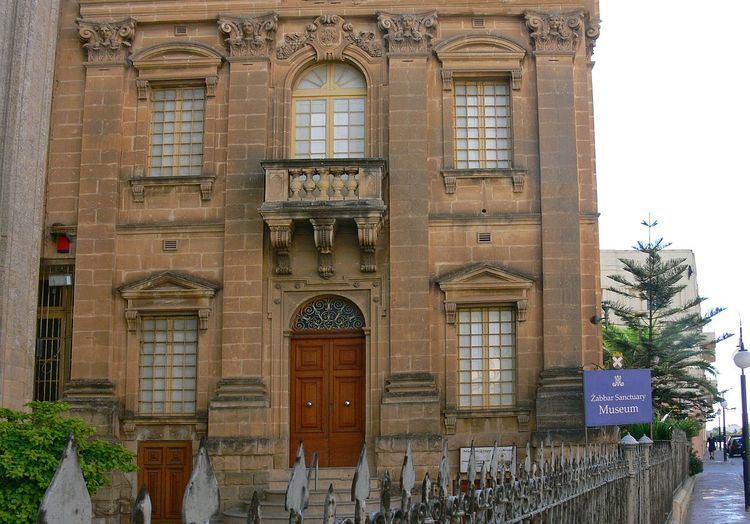Phone +356 2182 4383 | Type Parish museum | |
 | ||
Established 5 September 1954 (1954-09-05) Key holdings Religious, WWII and sea-related items Collections Remains from pre-history, antique church fragments of architecture, ex-voto and sea-related items, documents/coins/postal stamps Collection size Two floors and a platform Similar Hompesch Gate, Notre Dame Gate, Cottonera Lines, Della Grazie Battery, Fort Saint Rocco | ||
The Żabbar Sanctuary Museum (Maltese: Mużew tas-Santwarju Żabbar), also known as the Sanctuary of Our Lady of Graces, is the Parish museum of Żabbar, Malta, consisting of artifacts spanning from pre-history to modern contemporary. The majority of the belongings have a religious theme, while others are secular. It is a purposely built museum which met controversy over the exterior structure in a historic core, next to the parish church.
Contents
Build in the middle of the 20th century, it was renovated in 2003, and now has three floors of exhibits. It is run by volunteers and headed by the Parish priest of Żabbar. It is open for three hours daily, from nine in the morning till noon, with a fee of two euro per person. Entrance fees and donations go for the maintenance of the museum and the preservation of the collection.
History
The museum was founded by Monsignor Joseph Zarb. After Zarb was appointed as Parish priest of Żabbar, in 1943, he soon came to terms about the opportunity the sanctuary of Our Lady of Graces gave in terms of authentic historic artifacts. Being a researcher and a scholar, he listed all the belongings of the sanctuary - among which are weapons, slave chains, model ships, church vestments, altar fronts and votive paintings - which the Parish held. He later published the listed belongings in a book.
In the past, some of the heritage of the Parish was underestimated, prior to the opening of the museum and the whereabouts of some former belongings are dispersed or unknown. At one point, the Parish held circa 300 ex-voto and now has around 85, which are on display at the museum. The artifacts were, to the most of them, offerings to the patron of the village, Our Lady of Graces, collected throughout the years from people of various backgrounds.
With the construction and opening of the museum, Zarb managed to house and preserve a large collection of artifacts, dating from pre-history, the Order of St. John, the French occupation of Malta, the British period, to 20th century Malta. Some 21st century items are also included.
In the mid-20th century, the sanctuary received an official visit by Bishop Mikiel Gonzi when he crown both the Madonna and Baby Jesus, which are depicted on an venerable 18th century art of Our Lady of Graces.
Exhibits
The museum's exhibits consist of donations made to the museum by individuals, artifacts and paintings that were formerly located in the sanctuary, and artifacts bought by auction. Selective exhibits at the museum include:
A library of various literature is also available.
Paintings
Various works of art are exhibited in the museum, most of them with a religious theme as formerly they were in the sanctuary. The paintings include works by Rocco Buhagiar, Gian Nicola Buhagiar, Rafel Bonnici Cali, Michele Busuttil, Tousaint Busuttil, Giuseppe Calì, Giuseppe Maria Caruana, Giovanni Battista Conti, Giuseppe D'Arena, Stefano Erardi, Rafael Gagliardi, Tommaso Madiona, Mattia Preti, Italo Horatio Serge, Filippo Venuti and Francesco Zahra.
Other paintings in the museum were donated by individuals. Two of them are the 1683 Battle of Vienna, and another depicting the port of Messina in the 18th century. Also there are bozzettos of paintings in the sanctuary.
Building
In 1952, plans were made to build a museum adjacent to the parish church to exhibit the artifacts. The post-war Baroque exterior design of the museum building faced some controversy from the planning authority, however the permit was subsequently approved. The first stone was laid on September 2, 1952. On September 5, 1954, the museum was officiated by Jackie Frendo Azzoppardi and blessed by Monsignor Emmanuel Galea. It is the second Parish museum, after the Cathedral Museum in Mdina, and the first purposely build museum in Malta. In 2003, the museum was reopened after being closed for renovation with the initiative of parish priest Anton Cassar. The belongings are now sparse over the two floors of the building, and a platform at the first floor.
Administration
The museum is at the responsibility of the Parish of Żabbar. A commission of six volunteers, and the current Parish priest serving as president, direct the everyday operation of the museum; including the upkeep and restoration of the belongings. The museum's income derives from the parish and public donations.
The museum is generally open daily, for three hours, between 9 am and noon.
